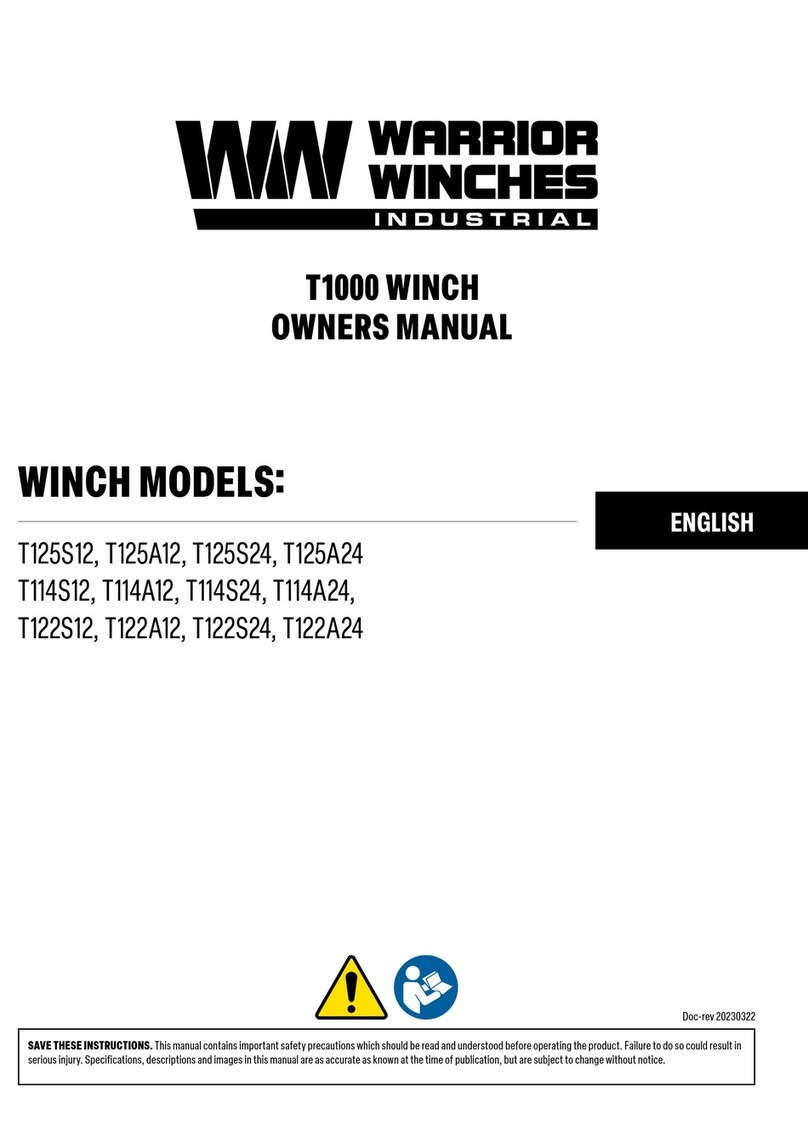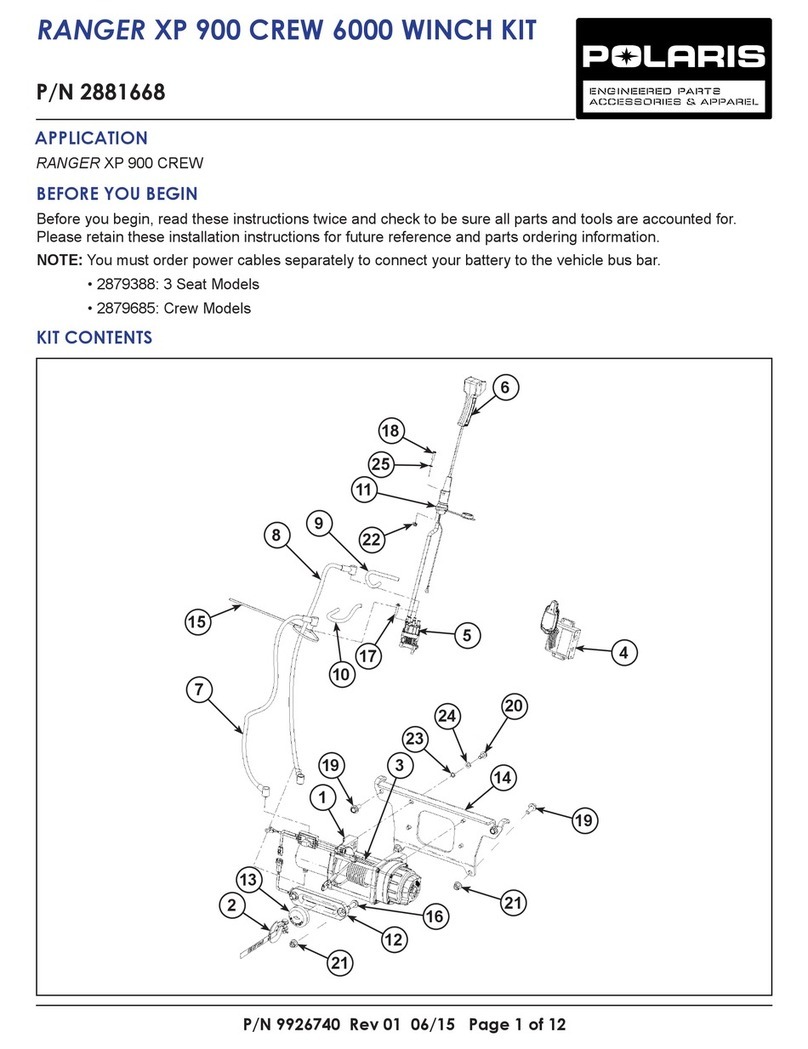Pullmaster R7 Series Technical reference manual

PMC 257
INSTRUCTION AND PARTS MANUAL
MODEL R7
PLANETARY HYDRAULIC WINCH
THE LOGICAL CHOICE
READTHISMANUALBEFOREINSTALLING,OPERATINGORSERVICING
THISPRODUCT. THISMANUALCONTAINSIMPORTANTINFORMATION.
MAKE THIS MANUAL AVAILABLE TO ALL PERSONS RESPONSIBLE
FORTHEOPERATION,INSTALLATION,SERVICINGANDMAINTENANCE
OFTHISPRODUCT.
070228

US.DIST.01.01.07 [PULLMASTER LOGO]
Pullmaster Limited Warranty Effective 8/1/2008
SUPERSEDES ALL PRIOR WARRANTIES
Seller warrants that each article (whether Gear Drive Products, Brake Products and/or Winch Products, all of which are covered hereunder)
sold under this order shall at the time of shipment (i) conform to applicable specifications, and (ii) be free from defects in material and
workmanship during normal and ordinary use and service (the "Warranty").
Buyer's exclusive remedy and Seller's sole obligation under this Warranty shall be, at Seller's option, to repair or replace any article or part
thereof which has proven to be defective, or to refund the purchase price of such article or part thereof. Buyer acknowledges that Buyer is
knowledgeable concerning the articles covered by this Warranty and sold in connection therewith which are being purchased, that Buyer has
reviewed this Warranty and that the remedies provided hereunder are adequate and acceptable to Buyer.
This Warranty shall expire one (1) year from the date the article is first shipped by Seller. Notice of claimed breach of this Warranty must be
given by Buyer to Seller within the applicable period. Such notice shall include an explanation of the claimed warranty defect and proof of
date of purchase of the article or part thereof for which warranty coverage is sought. No allowances shall be made by Seller for any
transportation, labor charges, parts, "in and out" costs, adjustments or repairs, or any other work, unless such items are authorized in writing
and in advance by Seller. Nor shall Seller have any obligation to repair or replace items which by their nature are expendable.
If an article is claimed to be defective in material or workmanship, or not to conform to the applicable specifications, Seller will either
examine the article at Buyer's site or issue shipping instructions for return to Seller. This Warranty shall not extend to any articles or parts
thereof which have been installed, used, or serviced otherwise than in conformity with Seller's applicable specifications, manuals, bulletins,
or instructions, or which shall have been subjected to improper installation, operation, or usage, misapplication, neglect, incorrect
installation, overloading, or employment for other than normal and ordinary use and service. This Warranty shall not apply to any article
which has been repaired, altered or disassembled, or assembled by personnel other than those of Seller. This Warranty shall not apply to
any article upon which repairs or alterations have been made (unless authorized in writing and in advance by Seller). This Warranty shall
not apply to any articles or parts thereof furnished by Seller to Buyer's specifications and/or furnished by Buyer or acquired from others at
Buyer's request.
SELLER MAKES NO EXPRESS WARRANTIES AND NO IMPLIED WARRANTIES OF ANY KIND, OTHER THAN THE WARRANTY
EXPRESSLY SET FORTH ABOVE. SUCH WARRANTY IS EXCLUSIVE AND IS MADE AND ACCEPTED IN LIEU OF ANY AND ALL
OTHER WARRANTIES, EXPRESS OR IMPLIED, INCLUDING WITHOUT LIMITATION THE IMPLIED WARRANTIES OF
MERCHANTABILITY AND FITNESS FOR A PARTICULAR PURPOSE.
Buyer expressly agrees that Seller is not responsible to perform any work or investigation related in any way to tensional vibration issues
and is not responsible for the detection or remedy of Natural Frequency Vibration of the mechanical system in which the unit is installed.
Buyer acknowledges, understands and agrees that this Warranty does not cover failures of the unit which result in any manner from the
operation of the machine or unit at vibration frequencies at or near the natural frequency vibration of the machine in such a way that damage
may result. Buyer expressly agrees that Seller is not responsible for failure damage or accelerated wear caused by machine or ambient
vibration. Further, Buyer acknowledges and agrees that Buyer is always solely responsible for determination and final approval of the
“application factor”which may be used in Seller’s calculations, and this application factor is 1.0 unless otherwise stated in Seller’s quotation
specifications.
The remedies for this Warranty shall be only those expressly set forth above, to the exclusion of any and all other remedies of whatsoever
kind. The limited remedies set forth above shall be deemed exclusive, even though they may fail their essential purpose. No agreement
varying or extending the foregoing Warranty, remedies, exclusions, or limitations shall be effective unless in a writing signed by an executive
officer of Seller and Buyer. This Warranty is non-transferable. If a party who had purchased articles from Buyer, or from persons in privity
with Buyer, brings any action or proceeding against Seller for remedies other than those set forth in this Warranty, Buyer agrees to defend
Seller against the claims asserted in such action or proceeding at Buyer’s expense, including the payment of attorneys’fees and costs, and
indemnify Seller and hold Seller harmless of, from and against all such claims, actions, proceedings or judgments therein. Buyer also
agrees to defend and indemnify Seller of, from and against any loss, cost, damage, claim, debt or expenses, including attorneys’fees,
resulting from any claims by Buyer or third parties to property or injury to persons resulting from faulty installation, repair or modification of
the article and misuse or negligent operation or use of the article, whether or not such damage to property or injury to persons may be
caused by defective material, workmanship, or construction. ADVISORY: Winches and hoists are not approved for lifting or handling
personnel or persons unless specifically approved in writing from Seller for the specific intended application.
Under no circumstances shall Seller be liable (i) for any damage or loss to any property other than the warranted article or part thereof, or (ii)
for any special, indirect, incidental, or consequential damage or loss, even though such expenses, damages, or losses may be foreseeable.
The foregoing limitations on Seller's liability in the event of breach of warranty shall also be the absolute limit of Seller's liability in the event
of Seller's negligence in manufacture, installation, or otherwise, with regard to the articles covered by this Warranty, and at the expiration of
the Warranty period as above stated, all such liabilities shall terminate. Buyer’s purchase of any article(s) covered by this Warranty shall
constitute acceptance of the terms and conditions hereof and shall be binding upon Buyer and Buyer’s representatives, heirs and assigns.
The laws of the Province of British Columbia shall govern Buyer’s rights and responsibilities in regard to this Warranty and the transaction(s)
subject thereto, and the Province of British Columbia shall be the exclusive forum and jurisdiction for any action or proceedings brought by
Buyer in connection herewith or any dispute hereunder. If any of the terms and conditions contained within this Warranty are void, the
remaining provisions thereof are and shall remain valid and enforceable.
Note: Prices and specifications contained in this price book are subject to change without notice.

PAGE 1
257REV.051117
The planetary hydraulic winches are made for hoisting and lowering loads and to be operated by trained and professional
personnel.Theyarenot designed foroperationsinvolvingliftingor movingpersonnel.Thewinchesare powered byhydraulic
power. The ropes / cables for hoisting operations are not supplied by PULLMASTER. The winches are always assembled
in an application, they do not function as an independent machine and it is not allowed to use them as such.
Thewinchesaretobeusedwithinthespecificationsaslistedinthemanualunder“SPECIFICATIONS”.Otheruseasforeseen
in the functional description of the hydraulic winch is not allowed without written permission from PULLMASTER.
FAILURE TO COMPLY WITH THE FOLLOWING SAFETY
RECOMMENDATIONS AND LOCAL RULES AND
REGULATIONS WILL RESULT IN PROPERTY
DAMAGE, SEVERE INJURY OR DEATH.
Definition: Caution indicates a potentially
hazardous situation which, if not avoided may
result in minor or moderate injury.
Definition: Warning indicates a potentially
hazardous situation which, if not avoided could
result in death or serious injury.
Definition: Danger indicates a potentially
hazardous situation which, if not avoided will
result in death or serious injury.
DANGER
SAFETY RECOMMENDATIONS
1. Do not install, operate or service winch before
reading and understanding manufacturer's
instructions.
2. The winch described herein is not designed for
operations involving lifting or moving personnel.
3. Do not lift or carry loads over people.
4. Do not exceed recommended operating pressure
(psi) and operating volume (gpm).
5. Do not jerk the winch. Always smoothly
accelerate and decelerate load.
6. Do not operate a damaged, noisy or
malfunctioning winch.
7. Do not leave a load suspended for any
extended period of time.
8. Never leave a suspended load unattended.
9. Winch should be maintained and operated by
qualified personnel.
10. Inspect winch, rigging, mounting bolts and
hoses before each shift.
11. Warm-up equipment before operating winch,
particularly at low ambient temperatures.
12. Verify winch function by raising and lowering a
full test load to a safe height before each shift.
13. Do not weld any part of the winch.
14. Verify gear lubrication and brake circulation
supply and return before operating winch.
15. Be sure of equipment stability before operating
winch.
16. Wear proper clothing to avoid entanglement in
rotating machinery.
17. Always stand clear of the load.
18. Use only recommended hydraulic oil and gear
lubricant.
19. Keep hydraulic system clean and free from
contamination at all times.
20. Maintain winch and equipment in good operating
condition. Perform scheduled maintenance regularly.
21. Keep hands clear when winding wire rope onto
the winch drum.
22. Do not use the wire rope as a ground for welding.
23. Rig the winch carefully. Ensure that the wire
rope is properly anchored to the correct cable anchor
slot at the cable drum.
24. Do not lift a load with a twisted, kinked or
damaged wire rope.
25. Consult wire rope manufacturer for size, type
and maintenance of wire rope.elen
26. Maintain five wraps of wire rope on the cable
drum at all times.
27. In case of a power failure or breakdown leading
to an unexpected stop of the hydraulic power circuit,
stand clear of the area and the load being hoisted,
take the necessary precautions to prevent access to
area where the load is halted.
28. The noise level of the winch is 83 dBA measured
on a distance of 1.00 meter, 1.60 meters high. The
measuring equipment used was: Realistic #42-3019.
29. Clean up any oil spillage immediately.
30. Wear proper clothing and personal protection
equipment such as, footwear, safety goggles and a
hard hat. Read manual first.

PAGE 2
DESCRIPTION OFTHE MODEL R7
GENERAL DESCRIPTION:
ThePULLMASTERModelR7isaplanetary,hydraulicwinchprimarilyintendedformobileorrecoveryadaptations.
The winch has equal speed in both directions and a freespool feature which can be operated manually or
hydraulically, depending on the option. The main components of this unit are:
✛hydraulicgearmotor
✛multi-disc brake with static and dynamic function
✛primaryplanetreduction
✛secondaryplanetreduction
✛finalplanetreduction
✛brakehousing
✛cabledrum
✛finaldrivehousing
✛freespoolmechanism
FUNCTION IN FORWARD ROTATION (PULLING):
Inforwardrotation,orwhenthewinch is pressurized for pulling, the outputtorque and rpmof thehydraulic motor
aretransmittedthroughthebrakeshaftandfreespoolcouplingtothefinalsungear.Theplanetgearsaredrivenby
thefinalsungearandcausetheplanethubtodrivethecabledrumatareductionof9.25:1.Whenaloadispulled,
anover-runningclutchwhichconnectsthemotordriveshafttotheautomaticbrakeassembly,permitsfreerotation
ofthesungear,withouteffectingthebrake.Whenthewinchrotationisstopped,theloadonthecabledrumcauses
the over-running clutch to lock and the load is held safely by the disc brake.
FUNCTION IN REVERSE ROTATION (PAYING OUT):
In reverse rotation, or paying out of a load, hydraulic pressure from the reverse side of the hydraulic motor is
channelledtothebrakepiston,causingthebrakepistontoreleasethemulti-discbrake.Thepressurerequiredto
releasethebrakeis400-600psi(28-42bar).Theover-runningclutch,connectingthemotordriveshafttothebrake
assembly,locks,causingthebrakediscstorotatebetweenstationarydividerplates.Iftheloadonthecabledrum
increasesthepayoutspeed,theresultingpressuredropinthebrakepistonincreasesfrictionbetweenthefriction
platesandslowsthedrum.Inthisway,acompletelysmoothpayoutspeedcanbeachievedinasteplessoperation
bymodulationofthewinchcontrolvalve.Whenthecontrolvalveisreturnedtoneutralposition,rotationstopsand
the disc brake applies automatically.
Duringpayoutoperationsofthewinch,thefrictioncreatedbythebrakediscsresultsinheat.Thisheatisdissipated
by the circulation of hydraulic fluid from the brake housing, supplied internally through the hydraulic motor. This
circulationflowisinternallyventedtothereturnlinethroughacheckvalvearrangementinsidethespeciallymodified
motor. The circulation flow is supplied only when the wire rope is payed out. A separate vent line connecting the
PULLMASTERModel R7 with thehydraulicreservoirisnotrequired (see TYPICALHYDRAULICCIRCUIT).
IMPORTANT: SAFETY VALVE
ThePULLMASTER ModelR7winchdoesnotrequirea drainlineupto100psipermissibleback
pressure in the brake housing. To indicate excessive pressure and potential damage to the
hydraulic motor or to the oil seal in the brake housing, a safety valve is installed on the motor
adaptor.
257REV.021217

PAGE 3
DESCRIPTION OF THE MODEL R7 CONTINUED
FUNCTION OF THE FREESPOOL MECHANISM:
MODEL R7-15-135-1M
Thismodelhasamanuallyactuatedfreespoolfunction.Thefreespoolfeatureisenabledbyturningthefreespool
handle180degreesinacounterclockwisedirection.Thiswilldisengagethefinalsungearfromthesecondaryplanet
hubandprovideforafreeturningdrum.Tore-engagethedrum,turnthehandle180degreesinaclockwisedirection.
IMPORTANT: Thefreespoolfunctioncannotbeengagedordisengagedunderloadorwhilethe
cable drum is rotating.
MODEL R7-15-135-1F
Thismodelhasahydraulicallyactuatedfreespoolfeature.Thefinalsungearispulledoutofengagementwiththe
secondary planet hub, by the freespool piston, which is spring applied and pressure released. To disengage the
sungear,hydraulicpressureof400psi(28bar)mustbesuppliedtothefreespoolreleaseport(seeINSTALLATION
DRAWING).Whenthehydraulicpressureisremoved,thesungearwillre-engage.
IMPORTANT: Thefreespoolfunctioncannotbeengagedordisengagedunderloadorwhile
the cable drum is rotating.
BREATHERRELIEFVALVE
Excessivepressureinthebrakehousingwilldamagetheoilsealseparatingthebrakehousingfrom
thedruminterior.Damagetothissealwillcausethedrumtofillupwithhydraulicfluid.Toprevent
damage to the drum seal and end cover of the final drive if the cable drum fills up with hydraulic
fluid,abreatherrelief(PARTSREFERENCEitem130)isinstalledontheendcover.Thebreather
reliefdoesnotpreventoilsealfailurebutservesasanindicatororwarningthatthesealsbetween
brakehousing and the cable druminterior have failedand must bereplaced immediately.
257REV.021217

PAGE 4
BASIC UNIT SERIES
R = Recovery winch
SIZE OF UNIT
OPTIONALREDUCTION RATIO
TYPE OF BRAKE
-12 Automaticbrake, counterclockwise drum rotation,intravent
-13 Externalbrakerelease,automaticbrake,counterclockwise
drumrotation,intravent
-14 External brake release, automatic brake, clockwise drum rotation, intravent
-15 Automatic brake, clockwise drum rotation, intravent
HYDRAULIC MOTOR
-135 Commercial M315hydraulic motor,1-1/2" gearsection. (Other gearsections
forthis motor areoptional)
DRUM SIZE
-1 STANDARDDRUM
6-3/8 drum diam. X 12-5/8 flange diam. X 8" between flanges.
OPTIONS
- F Hydraulicallyactuatedfreespooling
- M Manuallyactuatedfreespooling
NOTE:
Options for drum grooving are identified by a spec. number.
Clockwise and counterclockwise drum rotation is the direction of rotation for pulling, established by looking at
thehydraulicmotor.
EXPLANATION OF MODEL CODING
R7 X - XX - XX - XX - X
257REV.021217
All variations of the PULLMASTER Model R7 planetary winch are identified by the following code:

PAGE 5
OPTIONS
CLOCKWISE ROTATION:
ThedrumrotationofthestandardPULLMASTERModelR7planetarywinchisclockwiseforpullingwhenlooking
atthehydraulicmotorofthewinch.Drumrotationforcounterclockwisehoistingdirectionisavailableasanoption.
OPTIONAL HYDRAULIC GEAR MOTOR:
TheperformanceofthestandardPULLMASTERModelR7planetarywinchisbasedona
CommercialmodelM315
hydraulicmotorwithadisplacementof 1.9 cubic inches. The performance of the winch can be changed byusing
motorswith different displacements.
(Contact the factory for performance information if using motors with different displacements.)
ThePULLMASTERWINCHCORPORATIONwillconsiderotheroptionsforquantityrequirements.
257REV.010401

PAGE 6
SPECIFICATIONS
Performancespecificationsarebasedonstandardhydraulicmotor,gearratioandcabledrumwith5/8inchdiameter
wire rope. Performance specifications for winches supplied with optional motors are provided in attached
supplement.
CABLE DRUM DIMENSIONS (STANDARD DRUM):
Barreldiameter 6.38 in 162mm
Flangediameter 12.63in 321mm
Barrellength 8.00 in 203mm
CABLE STORAGE CAPACITY:
(Size of wire rope) 7/16in 278 ft 85 m
1/2 in 217 ft 66 m
9/16in 167 ft 51 m
5/8 in 124 ft 38 m
MAXIMUM OPERATING PRESSURE: 2100psi 145bar
MAXIMUM OPERATING VOLUME: 18(US)gpm 68 l/min
MINIMUM OPERATING VOLUME: 6(US) gpm 23 l/min
DRUM TORQUE AT MAXIMUM PRESSURE: 54,000lb-in 6,101 Nm
DRUM RPM AT MAXIMUM VOLUME: 15.5rpm
LINE PULL AT MAXIMUM PRESSURE:
Baredrum 15,429 lb 68.6kN
Full drum 9,000lb 40.0 kN
LINE SPEED AT MAXIMUM VOLUME:
Baredrum 28 fpm 8.7 m/min
Full drum 49 fpm 15 m/min
PERMISSIBLE SYSTEM BACK PRESSURE
AT MOTOR RETURN PORT: 100psi 6.9 bar
LUBRICATING OIL: Volume: 0.8(US) gal 3 liters
Refer to RECOMMENDATIONS for viscosity and instructions.
257REV.021217

PAGE 7
257REV.021217
FULL DRUM
15.0
49
FULL DRUM
57
15
45
12
34
9
23
6
11
3
40
12.2
35
10.7
30
9.1
25
7.6
20
6.1
15
4.6
10
3.0
5
1.5
12,000
53.4
9,000
40.0
6,000
26.7
3,000
13.3
1800 124
1500 104
1200 83
900 62
600 41
300 21
45
13.7
BARE DRUM
LINE PULL - kN
LINE SPEED - m/min
BARE DRUM
2100
0
18
0
15,4290
0 68.6 145
0
LINE PULL - lb
OIL PRESSURE - psi
OIL PRESSURE - bar
0
0
0
LINE SPEED - fpm
68
OIL VOLUME - (US)gpm
OIL VOLUME - l/min
PERFORMANCE GRAPHS
PG-R7-A
LINE PULL VS. OIL PRESSURE:
LINE SPEED VS. OIL VOLUME:
Performancegraphsarebasedonstandardhydraulicmotorandcabledrumwith5/8inchdiameter
wirerope.

PAGE 8
FILTER
PUMP
HYDRAULIC
RESERVOIR
800 PSI [55 BAR]
2(US)GPM [8 L/MIN]
REQUIRED FOR MODELS
SUPPLIED WITH EXTERNAL
BRAKE RELEASE OPTION
CONTROL VALVE
(MOTOR SPOOL)
4-WAY SPRING
RETURN TO CENTER
PRESSURE
RELIEF VALVE
TYPICAL HYDRAULIC CIRCUIT (R7-M)
HC-R7-M-A
257REV.021217

PAGE 9
257REV.021217
TYPICAL HYDRAULIC CIRCUIT (R7-F)
HC-R7-F-A
800 PSI [55 BAR]
2(US)GPM [8 L/MIN]
REQUIRED FOR MODELS
SUPPLIED WITH EXTERNAL
BRAKE RELEASE OPTION
RESERVOIR
HYDRAULIC
PUMP
FILTER
400 PSI [28 BAR]
PRESSURE REQUIRED
FOR FREESPOOL
PRESSURE
RELIEF VALVE
CONTROL VALVE
(MOTOR SPOOL)
4-WAY SPRING
RETURN TO CENTER

PAGE 10 257REV.021217
RECOMMENDATIONS
HYDRAULIC PRESSURE RELIEF:
The hydraulic circuit for the PULLMASTER planetary
winch requires a pressure relief set at the operating
pressure (see SPECIFICATIONS). Usually, a pressure
relief is part of the hydraulic control valve. Where this is
not the case, a separate pressure relief valve must be
installedandsetattherecommendedmaximumpressure.
HYDRAULIC RESERVOIR:
It is recommended that the hydraulic reservoir has
sufficient capacity to provide good heat dissipation in
ordertopreventover-heatingofthehydraulicfluid.The
hydraulic reservoir should be made from clean and
scale-free material to prevent contamination of the
hydraulicfluid.Inorder to prevent air frombeingmixed
with the hydraulic fluid, the reservoir should have an
over-flow baffle separating the return lines from the
suctionlineandallreturnlinesshouldenterthereservoir
belowthefluidlevel. Thereservoirshould be mounted
close to and above the hydraulic pump in a location
whichprovidesforfreeaircirculationaroundthereservoir.
HYDRAULIC HOSES:
The following hydraulic hoses are recommended for
maximum efficiency of the PULLMASTER Model R7
planetarywinch:
Pressure lines: Equivalent to SAE 100R12-12
Hydraulic freespool line: Equivalent to SAE 100R3-3
Itisrecommendedthatalargersizeofhydraulichoseis
installedwherethepressurelinesorthecirculationlines
are excessively long.
HYDRAULIC FILTER:
Hydraulicfilterrecommendationsforthehydrauliccircuit
ofthePULLMASTERplanetarywinch,basedonareturn
line filter, are given as follows:
Averageatmosphere: 10microns
Dustyatmosphere: 5 microns
Inordertopreventaccidentalstoppageofthereturnline
flow, the oil filter should have a by-pass feature.
USE OF AN E STOP:
The use of an E stop (emergency) is mandatory in the
controls circuit, the E stop is to be placed in the
operators control panel. The E stop has to be designed
and placed in line with EN 60204 and EN 418.
HYDRAULIC FLUID:
ThehydraulicfluidselectedforusewithPULLMASTER
planetary winches should be a high grade, petroleum
based fluid, with rust, oxidation and wear resistance.
Fluidcleanlinessandoperatingviscosity arecriticalto
winch reliability, efficiency and service life.
Foroptimumperformance,therecommendedviscosity
rangeatoperatingtemperatureis81-167SUS(16-36
CS).Forextremeoperatingconditionsofshortduration,
the maximum viscosity range of 58 - 4635 SUS (10 -
1000CS)shouldnotbeexceeded.
For optimum performance, the winch recommended
hydraulicfluidtemperatureoperatingrangeis80-150F
(27 - 66 C). For extreme operating conditions of short
duration,themaximumtemperaturerangeof-5 -180F
(-21 - 82 C) should not be exceeded.
LUBRICATION:
The winch gear train requires oil bath lubrication. The
winchisshippedfromthefactorywithoutlubricatingoil.
IMPORTANT: ADD LUBRICATING OIL BEFORE
RUNNING WINCH.
RefertoINSTALLATIONDIMENSIONSforlocationof
lubricating oil fill port. Refer to SPECIFICATIONS for
quantityofoilrequired.Fornormaloperatingtemperatures
use SAE 90 lubricating oil. Consult lubricating oil
supplier or factory for temperature beyond normal
operatingrange.
HYDRAULIC PUMP:
For maximum performance of the PULLMASTER
planetary winch, the hydraulic pump must supply the
maximumflowofhydraulicfluidatthehydraulicpressure
stated in SPECIFICATIONS.
HYDRAULIC CONTROL VALVE:
The standard control valve used for operation of the
PULLMASTERplanetarywinchmusthaveafour-way,
springreturntoneutralfeature,whichprovidesforopen
flowfromthepressureportsofthewinchtothereservoir
in neutral position of the control (motor spool). It is
importanttopointoutthatgoodspeedcontrol,especially
whenpaying-ingoutaload,dependsonthe“metering”
characteristics of the control valve. The better the oil
flow is “metered” the better will be the speed control.

PAGE 11
INSTALLATION INSTRUCTIONS
Theinitial installation ormounting of aPULLMASTER planetary winch iscritically important forproper operation
andperformance.Ifthewinchismountedtoanunevensurface,thecentrelineoftheunitcanbedistortedtoapoint
wherethewinchwillnotoperateineitherdirection.Itisthereforeveryimportantthatthefollowinginstructionsare
observedwhena PULLMASTER planetary winchisinstalled:
1) Makecertainthat themountingplatformissufficiently stronginordertoavoid deflectionwhenaloadis lifted.
2) Set the winch on the mounting platform and check for surface contact on all mounting pads of the winch.
3) If there is a space between the mounting surface and one of the mounting pads, the mounting surface is not
even and the space below the mounting pad must be shimmed. If this condition exists, proceed as follows:
a) Installmountingboltssnugtightonthethreemountingpadswhichareincontactwiththemountingsurface.
(FormountingboltsizeandgradeseeINSTALLATIONDIMENSIONS.)
b) Measurethespaceunderneaththefourthmountingpadwithafeelergaugeanduseshimstockofequivalent
thickness in the space between the mounting pad and the mounting surface.
c) Only after this procedure should the fourth mounting bolt be installed. Tighten all four bolts per BOLT
TORQUECHART.
4) Fill the winch with lubricating oil. (See SPECIFICATIONS for oil volume required.)
5) Userecommendedcircuitcomponentsandhydraulichoses.
6) Verifythatbreatherrelief,item130,isinplaceonendcoveraboveoillevel.Endcovermayneedtoberotated
if winch is not installed upright.
IMPORTANT:
Donotreplacebreatherrelieforsafetyvalvewithapipeplug.Thebreatherreliefdoes
not prevent oil seal failure but serves as an indicator or warning that the oil seals
betweenbrakehousingandthecabledruminteriorhavefailedandmustbereplaced
immediately. The safety valve acts as a warning that excessive pressure is present
in the brake housing and must be rectified immediately.
7) The circulation return line of the winch should be plumbed in such a manner that the brake housing remains
filledwithoilatall times.Connectthe returnlinedirectlytoreservoir.Donotconnecttoa commonreturnline.
FAILURETOFOLLOWINSTALLATIONINSTRUCTIONSCOULD
RESULT IN PROPERTY DAMAGE, SEVERE INJURY OR DEATH.
DANGER
257REV.021217

PAGE 12
OPERATING INSTRUCTIONS
FAILURETOFOLLOWOPERATINGINSTRUCTIONSCOULD
RESULT IN PROPERTY DAMAGE, SEVERE INJURY OR DEATH.
AfterthePULLMASTERplanetarywinchhasbeeninstalledinaccordancewiththeINSTALLATIONINSTRUCTIONS,
the wire rope can be fastened to the cable drum.
IMPORTANT: The ropes, chains, slings, etc. are not part of the winch and are not covered by this manual.
Refer to manufacturer’s handling, inspection and maintenance recommendations to avoid
potential accidents. For selection of ropes, etc. please check following product standards: DIN
15020, prEN818-1/9, prEN 1492-1/2, prEN 1677-1/3 and other relevant product standards.
1) ThecabledrumofthePULLMASTERplanetarywinchhastwocableanchorslots,oneforclockwiseandone
forcounterclockwise pulling.Standardrotationfor pullingisclockwisewhen lookingatthehydraulicmotorof
the unit. It is critical to select the cable anchor slot which will permit winding of the wire rope on the drum in
thecorrectdirectionofrotation.Ifthe wire rope is wound on thecable drum inthe wrongdirection ofrotation,
the winch will have no braking capacity. Each winch is shipped from the factory with a label on the drum
indicating the correct cable anchor slot.
WIREROPEINSTALLATION
Clockwisepulling winchshown.(Use
cable anchor slot on opposite side of
drumforcounterclockwisepulling
winch.)
Feedthe wireropethroughthe cable
anchor slot. Loop rope back into slot as
shown. Insert cable anchor into slot,
small end first and long side nearest the
drum flange. Pull rope tight to wedge
rope in slot.
2) Onwireropeinstallation,caremustbetakenthatthewireropeiswrappedcompletelyaroundthecableanchor
andproperlypulledintothecableanchorslotinthecabledrum. Thecabledrumrequires5wrapsofwirerope
for safety.
3) Thewinchoperationiscontrolledbyasinglecontrolvalveleverwhichhasaforward,areverseandaneutral
position.Speed control in either directionis obtained bymodulation of thecontrol valve lever. Maximum line
speedineither direction is obtainedwhenthe control valve leverismovedas far as itcango. The disc brake
of the winch will come on automatically when the winch control lever is returned to neutral.
4) Alwayswarmupequipmentpriortooperatingwinch,particularlyinlowambienttemperature.Circulatehydraulic
oilthroughthewinchcontrolvalveforseveralminutestowarmthehydraulicsystem.Toprimethewinchwith
warm oil, operate the winch at slow speed, forward and reverse, several times.
5) Preventcorrosiondamagetowinchinterior.Ifnotusedregularly,runwinchupanddownatleastonceevery
twoweeks.
6) Toensureproperwinch installation and function, raise and lower afull testload to asafe heightbefore using
winch for regular operation at the start of each shift.
If,afteranewinstallation,thewinchdoesnotfunctionproperly,refertotheTROUBLESHOOTINGsectionof
this manual.
SI1013-R7
DANGER
257REV.051117
CABLE ANCHOR SLOT
CABLE ANCHOR

PAGE 13
TROUBLE SHOOTING
FAILURE PROBABLE CAUSE
Winch will not produce line pull at maximum
pressure as listed in SPECIFICATIONS.
GENERAL:
In most cases, when the hydraulic winch does not perform satisfactorily, the cause of malfunction is found
somewhere in the hydraulic circuit. Before the winch is removed from its mounting and disassembled, all of the
hydraulic circuit components should be checked for proper function.
IMPORTANT:
The hydraulic oil volume relates to the line speed or rpm of the winch.
Therefore,ifthewinch does not produce themaximumratedlinespeed, a loss of hydraulicflowsomewherein
thehydrauliccircuitsystemcanbeanalysed. Ifthisconditionexists,installaflowmeterintothehydrauliccircuit
to check the volume supplied to the motor ports when the winch control is completely opened. The flow meter
should indicate the maximum operating volume. If the test described indicates a loss of hydraulic flow, check
the hydraulic pump, the relief valve and the control valve.
The hydraulic pressure relates to the line pull or lifting capacity of the winch.
If the winch will not pull the maximum rated load, install a pressure gauge into the pressure line leading to the
pullingportonthehydraulicwinchmotor. Stallthewinchtopreventrotationofthedrumandthenopenthecontrol
valveandcheckthehydraulicpressurereadingoftheinstalledpressuregauge. Ifthepressurereadsbelowthe
specified maximum operating pressure, look for trouble in the hydraulic pump, the relief valve and the control
valve. Whencheckingoilpressureofoilvolumeanywhereinthehydraulicsystem,makecertainthatthehydraulic
pumpisrunningatmaximumoperatingrpm. Installationsusingabeltdriveforhydraulicpumpmustbechecked
for belt slippage. Verify that hydraulic reservoir is filled to the top level.
Only if thehydraulicsystemhasbeen checked and found tobe inorder,usethefollowingindicationsforprobable
causes of failure in the winch:
a) Winch is mounted to an uneven surface (see
INSTALLATIONINSTRUCTIONS).
b) Cable sheaves or block purchase operated with the
winch are not turning freely.
c) Damage or wear in the hydraulic motor.
d) Excessive back pressure in the hydraulic system.
e) Relief valve may be set too low.
a) Winch is mounted to an uneven surface (see
INSTALLATIONINSTRUCTIONS).
b) Cable sheaves or block purchase operated with the
winch are not turning freely.
c) Damage or wear in the hydraulic motor
d) Excessive back pressure in the hydraulic circuit.
a) Leakage out of the brake piston prevents the brake
from being released against the brake springs. This is
caused by damaged O-ring seals on the brake piston.
b) TheO-ringseals,onthebrakereleasechannelbetween
the motor adaptor and the brake housing is damaged.
If this failure occurs there will be substantial leakage
from between the motor adaptor and brake housing.
c) Insufficienthydraulicpressure(seeSPECIFICATIONS
for minimum operating pressure).
d) Winch is mounted to an uneven surface (see
INSTALLATIONINSTRUCTIONS).
e) Hydraulic pressure is not reaching the brake piston
(plugged brake release orifice in the brake housing).
Winch will not produce line speed at maximum
volume as listed in SPECIFICATIONS.
Winch will not reverse.
257REV.010401

PAGE 14
TROUBLE SHOOTING
Refer to the SERVICE INSTRUCTIONS if it becomes necessary to disassemble the Model R7 winch.
FAILURE PROBABLE CAUSE
a) Brake plates or divider plates have been damaged by
contamination in the hydraulic fluid, or lack of circulation flow in
the brake housing.
b) Brake piston is seized in the brake housing because of
contamination in the hydraulic fluid.
c) Excessive back pressure in the return line causes the brake to be
released. Back pressure in the circuit return line should be held
below 100 psi (7 bar).
d) Control valve has incorrect spool, which traps hydraulic pressure
in the brake piston when the control valve handle is returned to
neutral position. For proper function of the automatic brake, both
pressure ports of the winch must be open to the reservoir in neutral
position of the control valve.
e) Wire rope is fastened to the incorrect cable anchor slot.
f) The over-running clutch, which connects the motor shaft with the
brake assembly, is damaged.
g) Winch supplied with external brake release is not plumbed per
HYDRAULIC CIRCUIT. Failure to vent external brake release
port to reservoir may trap pressure and cause winch brake to slip.
a) Pump is too slow. Pump rpm must be maintained at normal
operating speed when a load is lowered.
b) Brake is running too hot. This is caused by a complete lack of, or
insufficient circulation flow. To check the circulation, observe the
flow of oil from the circulation return line of the winch (approx. 3.5
(US) gpm - 13 l/min when the winch is reversed.
c) Control valve has poor metering characteristics.
d) Damaged brake plates or divider plates.
e) Air mixed with hydraulic oil (foamy oil).
a) Insufficient pressure to disengage freespool shaft. Check with a
pressure gauge to verify that 400 psi (28 bar) is being supplied
to the freespool release port.
b) If pressure is being lost at the freespool release port, then the o-
ring that seals the freespool piston, item 265, has been damaged.
c) The freespool piston may have become seized, due to foreign
material in the hydraulic fluid.
d) There is a load on the drum, or the drum is turning. The drum must
be stopped and there can be no load on the wire rope, while the
freespool option is used.
a) Oil leaks from the hydraulic motor flange and the motor adaptor
are caused by damaged O-ring seals.
b) Oil leaks occurring between the cable drum flanges and housings
arecausedby excessive pressure in thebrakehousing. Excessive
pressure will damage the oil seal which separates the brake
housing from the cable drum interior.
c) If the breather relief on the end cover leaks, the seal between the
drum interior and the brake housing is damaged and must be
replaced. This condition is caused by excessive pressure in the
brake housing of the winch, operation with the incorrect hydraulic
fluid during cold weather, or a restriction in the circulation return
line leading back to tank.
Brake will not hold
Brake vibrates when lowering a load
Oil leaks
257REV.021217
Cable drum will not freespool

PAGE 15
SERVICE INSTRUCTIONS
GENERAL:
Before attempting disassembly of the PULLMASTER Model R7 planetary winch with freespool, the following
instructionsshould bereadandunderstood.
It issuggestedthatallexpendablepartssuchaso-ringsandoilsealsarenotreusedonreassembly. Itistherefore
important to have a seal kit, part no. 26035, on hand before the unit is taken apart.
A clean working area is of prime importance, similar to conditions used for service work on any other hydraulic
component.Allparts,astheyareremovedfromthewinchassembly,shouldbecarefullyinspectedforwearand
damageandbethoroughlycleanedbefore installation.
During reassembly, lubricate all o-rings and oil seals with grease before installation.
Inthefollowingserviceinstructions, reference to parts is madebypartdesciptionandreference number, which
you will find in one of the three parts lists and associated group drawings.
DISASSEMBLY
FORTHEMAJORITYOFREQUIREDSERVICEORREPAIRWORK,DISASSEMBLYISREQUIREDONLYON
THE BRAKE HOUSING ASSEMBLY OF THE PULLMASTER MODEL R7 PLANETERY WINCH. There are no
specialtoolsneededforthe serviceandrepair workandnoadjustmentsorcalibrationsarenecessary.Proceed
with the disassembly as follows:
REMOVE HYDRAULIC MOTOR ASSEMBLY:
1) Removetwocapscrews,item815,togetherwithlockwashers,item817,whichattachthemotortothemotor
adapter, item 800. The hydraulic motor, item 850, can now be pulled out of the winch assembly.
2) Removeanddiscardo-ring,item811.
3) Removetheconnectingtube,item830,anddiscardo-rings,item831,frombothendsoftheconnectingtube.
4) Thestandardmotor of the ModelR7isaCommercialM315hydraulicgear motor with a1-1/2"gearsection.
Ifaproblemisanalysedtobeinthehydraulicmotor,werecommendthataCOMMERCIALINTERTECHdealer
be contacted for parts and service. Normally, a problem in the hydraulic motor occurs in the gear section.
Ifthehydraulicmotorisdisassembled,theoriginalflangesectionofthemotormustbere-usedinordertoprovide
the required porting for the operation of the automatic brake, and for the circulation flow.
REMOVE BRAKE ASSEMBLY:
1) Remove the four capscrews, item 821, and lockwashers, item 823, from the motor adaptor, item 800. The
motor adaptor can now be taken from the brake housing assembly, and o-ring, item 707, discarded.
NOTE: Since the brake springs, item 752, apply pressure against the inside of the motor adaptor, it is
recommended that the hex capscrews are unscrewed one turn at a time until the spring pressure has been
released.
2) Afterthehydraulicmotorassemblyhasbeenremoved,allpartsofthebrakeassemblyareaccesible.Remove
the 6 brake springs, item 752.
3) Pull the brake piston, item 750, out of the brake housing. Discard o-rings, item 751 and item 753. Remove
pipeplug,item757,andmakecertainthattheholeoftheorificeplug,item754,isclearandunobstructedby
debris and contamination. Re-install pipe plug, item 757.
Checkthebrakepistonoutsidediametersandtheinsidediametersofthebrakehousingforsurfacescratches
duetoparticlesinthehydraulicfluid(contamination).Ifthereisanyevidenceofsurfacedamage,polishwith
fine emery cloth.
4) Pullthemotordriveshaft,item730,outofthebrakehousingtogetherwithhubassembly.Removethebrakehub
assembly by taking off circlip, item 727. Remove the 2 sprag clutch aligners, items 722 and 724, from both
257REV.021217

PAGE 16
SERVICE INSTRUCTIONS CONTINUED
257REV.010401
sides of the brake hub, item 720, and inspect for wear. Carefully remove the sprag clutch, item 723, and
inspectfordamage.Inspectthesurfacesofthemotordriveshaftandthebrakehub,wherethespragclutch
engages. If these surfaces show any deep indentations or surface damage, they should be replaced.
5) Remove the 7 divider plates, item 713, and the 6 brake plates, item 716. Inspect these parts for wear or
damageandreplace if necessary.
6) Remove brake spacer, item 712, two thrust washers, item 737, and thrust bearing, item 739.
7) The oil seal, item 711, along with backup washer, item 710, which seals the brake housing from the cable
druminterior, cannowberemoved anddiscarded
Allpartshave now been removedfromthe brake housing, andthereisno need for furtherdisassembly,unless
a failure has been analysed in the remaining winch assembly.
REASSEMBLY OF BRAKE HOUSING ASSEMBLY:
Unlessotherwisespecified,use torque chart at back of manual.
1) Cleanallpartsthoroughlybeforereassemblyandapplygreaseliberallytoallo-ringsandoilseals.Useonly
new o-rings and oil seals (Seal kit for winch assembly, part no. 26035).
2) Install new backup washer, item 710, and new well lubricated oil seal, item 711, in the bore of the brake
housing.
3) Install thrust bearing, item 739, with a thrust washer, item 737, on each side, into the brake hub.
4) Installthespragclutch,item723,intheboreofthebrakehub,item720.Insertthespragclutchaligner,item
722,intooneside of the brake hub.Inserttheothersprag clutch aligner, item 724,intotheotherside of the
brakehub.Carefullyslidethemotordriveshaft,item730,throughthespragclutchaligner,item724,intothe
brake hub assembly and fasten into place by installing circlip, item 727.
IMPORTANT:Forthe-14and-15brakeconfigurationsthespragclutchmustbeinstalledinsuchamannerthat
themotorendofthemotordriveshaftturnsfreeinclockwiserotationandlocksupincounterclockwiserotation.
For the -12 and -13 brake configurations, the rotation is opposite to the above procedure.
5) Inserttheexternallysplinedendofthemotordriveshaft,togetherwiththebrakehubassembly,intothebrake
housing and rotate it until it engages into the spline of the primary sungear, item 440.
6) Insertbrakespacer,item712,sothattheflatsidefaceouttowardsyou,andinstalladividerplate,item713,
againstit.Then,startingwithabrakeplate,item716,alternatethe6brakeplateswiththeremaining6divider
plates. The brake stack must finish with a divider plate.
7) Installwellgreasedo-rings,item751and753,ontothebrakepiston,item750.Carefullyinsertthebrakepiston
intothebrakehousingandturnthepistontolineuptheborefortheconnectingtube,item830,withthebore
in the motor adapter, item 800. Install the six brake springs, item 752.
8) Checkthe safety valve,item 840, onthe motor adaptor forproper sealing. Installnew, well greasedo-ring,
item707,ontheflangeofthemotoradaptor,andfastenthisparttothebrakehousingbyusingfourhexhead
capscrews, item 821, and lockwashers, item 823. These screws should be tightened evenly, one turn at a
time, against the pressure exerted by the brake springs.
IMPORTANT:Forthe-14and-15brakeconfigurations,themotoradaptormustbereassembledwiththemounting
holes for the hydraulic motor in a parallel position to the mounting surface of the winch, and the bore for the
connecting tube on the right side. For the -12 and -13 brake configurations, the bore for the connecting tube is
located on the left hand side.
9) Installnewo-rings,item831,oneachendoftheconnectingtube,item830,andapplygreaseliberally.Insert
the long end of the connecting tube into the motor adaptor.
10) Installnew,wellgreasedo-ring,item811,ontheflangeofthehydraulicmotorandfastenthemotorbyusing
two hex head capscrews, item 815, and lockwashers, item 817.

PAGE 17
SERVICE INSTRUCTIONS CONTINUED
257REV.010401
The Pullmaster Winch is now reassembled and ready for installation.
DISASSEMBLY OF FINAL DRIVE ASSEMBLY:
Ifa failure occursin the mechanismlocated inside thefinal drive housing,or the winchhas to bedisassembled
beyond the point described in the preceding chapter, proceed as follows:
1) Remove the drain plug, item 121, from the freespool cover, item 250, and drain the lubricating oil from the
finaldrive assembly andthecable drum interior.In order to drainall of theoilout of thecable drum interior,
the winch should be tipped to an angle, and the filler plug, item 503 removed.
2) Afterdrainingalllubricatingoilfromthefinaldrivehousing,item100,removeinternalretainingring,item124,
and knock spring pin, item 259, up into the hole in the final drive housing, for clearance. The freespool
assembly along with the final sungear can now be pulled out of the final drive housing and put aside. If a
problemexistsinthefreespoolassembly,skipaheadtothesectiontitledDISASSEMBLYOFFREESPOOL
ASSEMBLY.
3) Pulloutthefinalplanethubassemblyandinspectforwearordamage.Ifthefinalplanethubgears,item320,
haveto be removed, take offcirclip, item 311,from planet pin,item 310, and press theplanet pin outof the
finalplanethub,item300.Removethefinalplanetgear,item320,togetherwithlooserollers,item323,and
thrust washers, item 321. NOTE: On reassembly these thrust washers must be installed.
All parts have now been removed from the final drive assembly. If further disassembly is required, proceed as
follows:
DISASSEMBLY OF CABLE DRUM ASSEMBLY:
If a problem is analysed to be in the primary or secondary reductions, the cable drum assembly must be
disassembled. After draining lubrication oil, proceed as follows:
1) Remove 16 hex head capscrews, item 555, along with lockwashers, item 553, from the final housing, item
100, and the brake housing, item 700, and remove the two tie bars, item 556 and 558.
2) Thebrakehousing,item700,cannowbepulledoutofthecabledrum,item500.Thecylindricalrollerbearing,
item509, comes apart withthe outer race remainingin the cable drum,andthe rest staysonthe hub ofthe
brakehousing.Removeanddiscardoilseal,item515,andinspectnylonspacer,item704,forwear.Replace
spacer if less than 7/32” thick.
3) Pull the primary planet hub assembly out of the cable drum. Check nylon spacer, item 402, for wear and
replace if less that 7/32” thick.
4) Iftheprimaryplanetgears,item420,havetoberemoved,firstremoveprimarysungear,item440,andsungear
stopper,item494,fromtheprimaryplanethubassembly.Takeoffcirclip,item411,fromplanetpin,item410,
andpresstheplanetpinoutoftheprimaryplanethub,item400.Removetheprimaryplanetgear,item420,
together with needle bearings, item 423, and thrust washers, item 421.
NOTE:Onreassemblythesethrustwashersmustbere-installed.Also,ensurethatthesecondarysungear,item
490, with circlip, item 491, are in place before planet gears are re-installed.
5) Thesecondaryplanethubassemblycannowbepulledoutofthecabledrum.Inspecttheplanethubstopper,
item 453, for wear and replace if less than 5/16” thick.
6) Inspect the internal splines of the secondary planet hub for excessive wear or broken teeth, and replace if
necessary.Ifthesecondaryplanetgears,item470,havetoberemoved,takeoffcirclip,item461,fromplanet
pin, item 460, and press the planet pin out of the primary planet hub, item 450. Remove the primary planet
gear,item470,togetherwithloose rollers, item 473, and thrust washers, item 471. NOTE: On reassembly,
these thrust washers must be re-installed.
7) To separate final housing, item 100, from brake housing, item 700, first remove circlip, item 513, from the
hubof the cabledrum.Inserttwoheel bars betweenthedrumflangeand the finalhousingandcarefullypry
the cable drum out of ball bearing, item 103. Remove the internal retaining ring, item 104, to remove ball
bearing, item 103, from inside the final housing. Remove and discard oil seal, item 105.

PAGE 18
SERVICE INSTRUCTIONS CONTINUED
257REV.010401
DISASSEMBLY OF FREESPOOL ASSEMBLY:
Ifa problem isoccuringin the freespoolassembly, follow instructions 1and 2 fromthesection DISASSEMBLY
OFFINALDRIVEASSEMBLY,thendependingonwhetheryouareworkingonahydraulicormanuallyactuated
model,proceedformhere.
HYDRAULIC FREESPOOL (R7-X-135-1F):
1) Removefourhexcapscrews,item253,andlockwashers,item255,fromtheendofthefreespoolassembly.
Since the freespool spring, item 280, applies pressure against the inside of the freespool cover, it is
recommendedthatthehexcapscrewsare unscrewed one turn at a time until the spring pressure has been
released.
2) Discardo-ring, item 257, and removethe freespool spring.
3) Removethefreespoolpiston,item264,alongwiththefinalsungear,item340,fromthefreespoolcoverand
discardo-rings,item265and277.Inspecttheoutsidediameterofthepistonandtheinternaldiameterofthe
housing for any surface scratches due to particles in the hydraulic fluid (contamination). If there is any
evidence of surface damage, polish with fine emery cloth.
4) Inspect nylon planet hub stopper, item 126, and replace if less than 1/8” thick. Remove and discard o-ring,
item 123, from outside of freespool housing.
5) Inordertoseparatethefinalsungear,item340,fromthefreespoolpiston,removecirclip,item 269.Inspect
the two splines on the end of the final sungear for wear and cracks, and replace if necessary.
6) To separate the ball bearing, item 291, from the final sungear, remove circlip, item 269.
MANUAL FREESPOOL (R7-X-135-1M):
1) Removehexheadcapscrew,item297,andlockwasher,item298,toallowremovaloffreespoolhandle,item
254, form nut drive, item 256.
2) Remove four hex head capscrews, item 253, and lockwashers, item 255, from seal carrier, item 252. For
correct positioning of the seal carrier upon reassembly, make a chalk mark on the outside top flange of the
sealcarrierandthefreespoolhousing,item250.Pullthesealcarrieroutofthefreespoolhousinganddiscard
o-ring, item 257, and oil seal, item 299.
3) Removeindex,item272,detentspring,item276,andspringseat,item284.Checkthesepartsforwearand
replace if necessary.
4) Turn the nut drive, item 256, to disconnect from the follower, item 266. Inspect the three spring pins, item
278,and replaceifdamagedorworn.
5) Removecirclip,item288,andpullthefinalsungear,item340,togetherwiththefollowerandballbearing,item
291, out of the freespool housing.
6) Remove circlip, item 295, from the inside of the follower and pull the ball bearing, together with the final
sungear, out of the follower.
7) To separate the ball bearing, item 291, from the final sungear, remove circlip, item 269.
The PULLMASTER Model R7 with freespool has now been completely disassembled.
REASSEMBLY:
Reassemblethewinchfollowingreverseprocedureofdisassembly.Allpartsshouldbethoroughlycleanedand
only new, well greased o-rings and oil seals should be used.
IMPORTANT:
Beforeoperationofthewinch,refilllubricatingoil(SAE90)throughtheoillevelholeintheendcover,andthrough
theoil fillerholeinthecabledrum.TheproperquantityisindicatedonthewinchSPECIFICATIONsheet.Toensure
properreassembly,run the winch inbothdirectionswithoutload, prior to regularoperation.
This manual suits for next models
2
Table of contents
Other Pullmaster Winch manuals
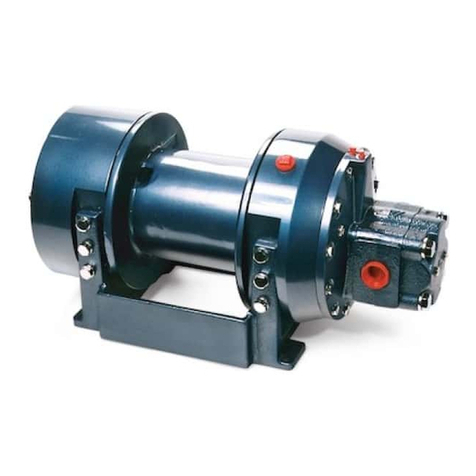
Pullmaster
Pullmaster M5 Technical reference manual

Pullmaster
Pullmaster PL8 Technical reference manual

Pullmaster
Pullmaster M25 Technical reference manual
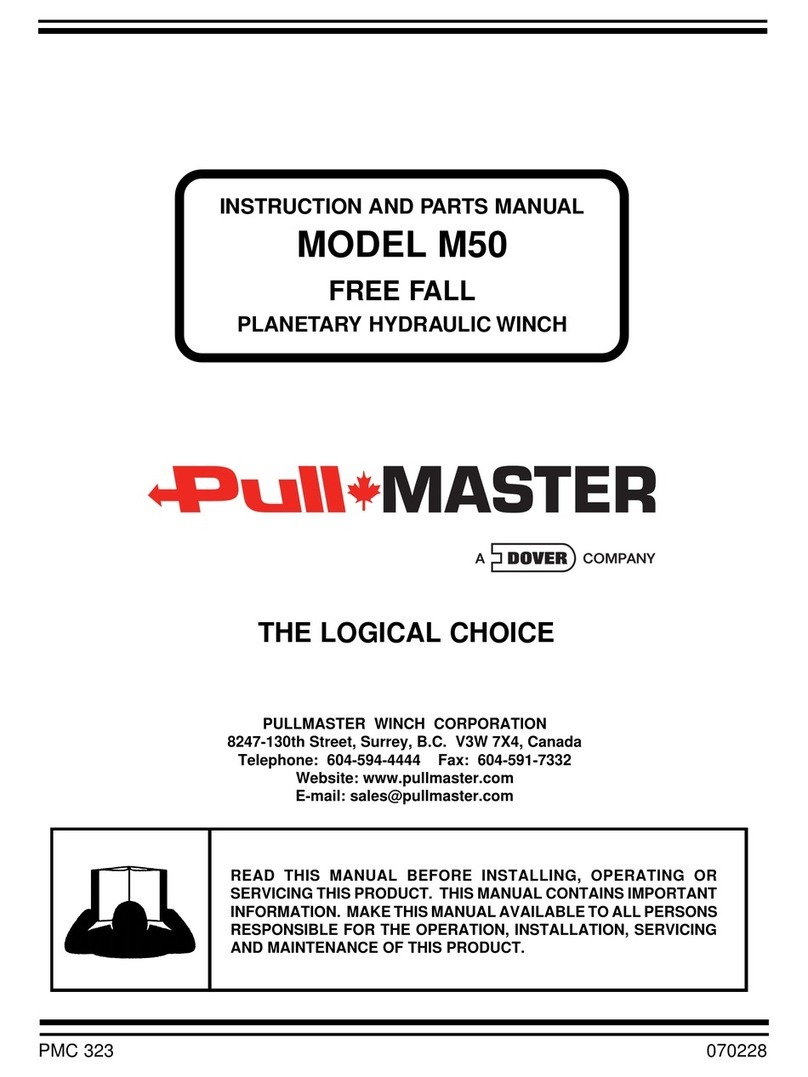
Pullmaster
Pullmaster M50 Technical reference manual
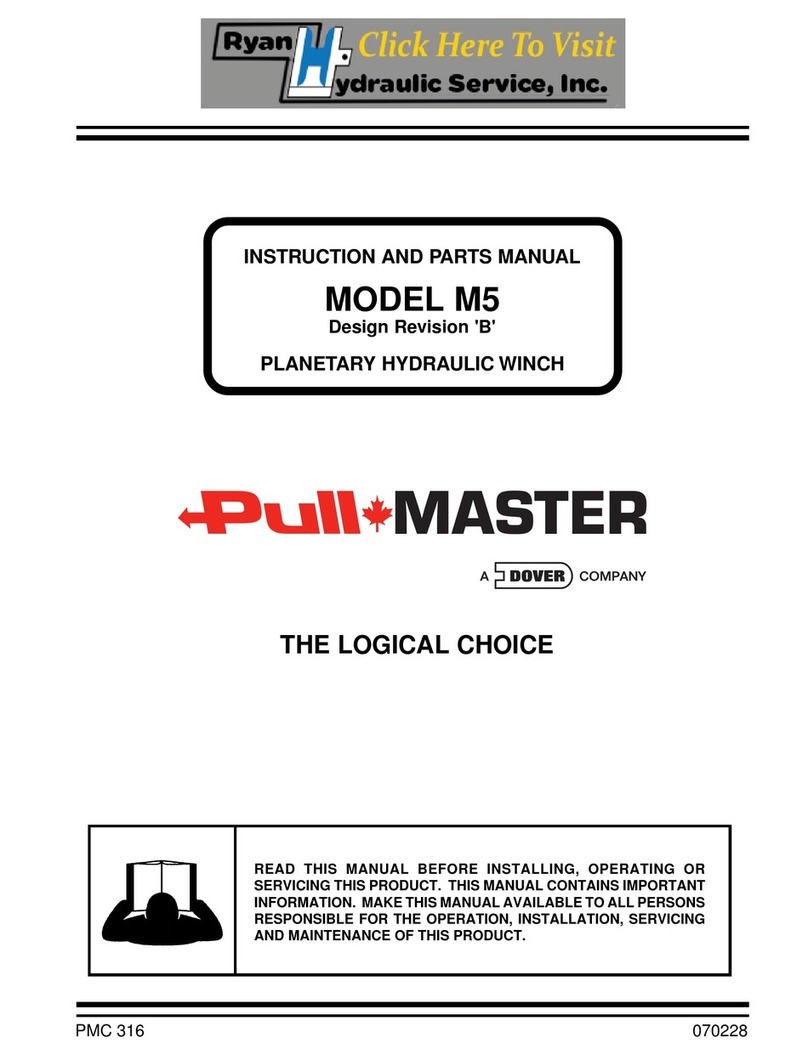
Pullmaster
Pullmaster M5 Technical reference manual
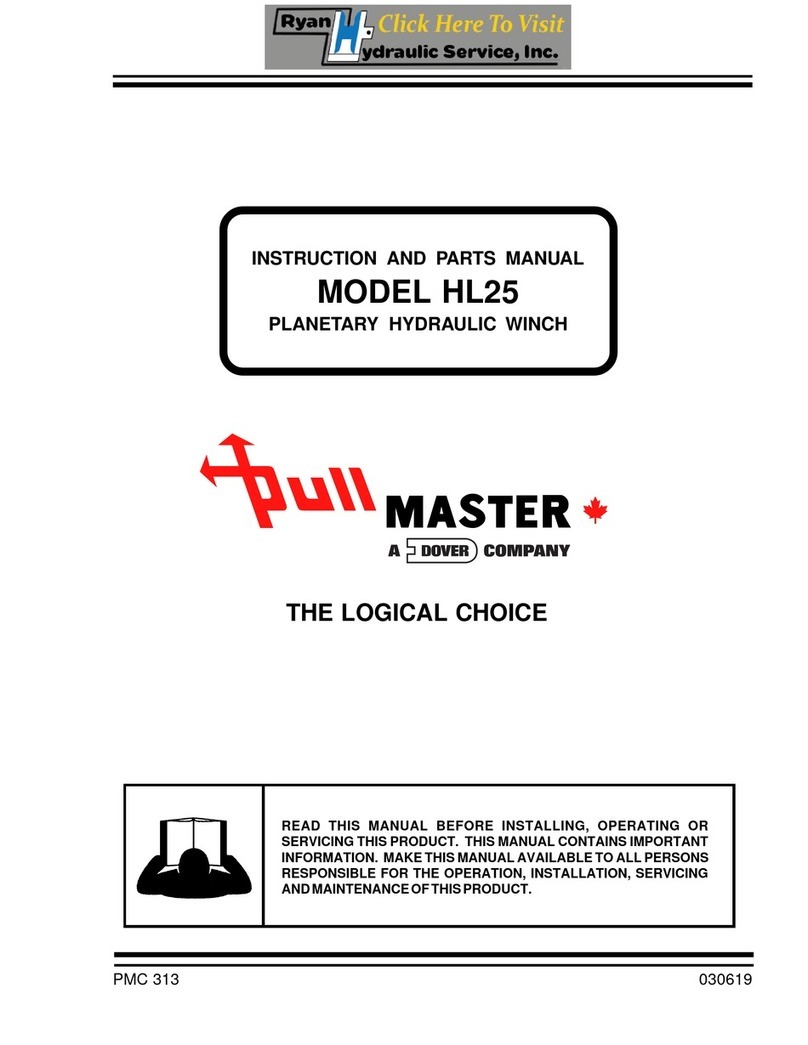
Pullmaster
Pullmaster HL25 Technical reference manual
Popular Winch manuals by other brands
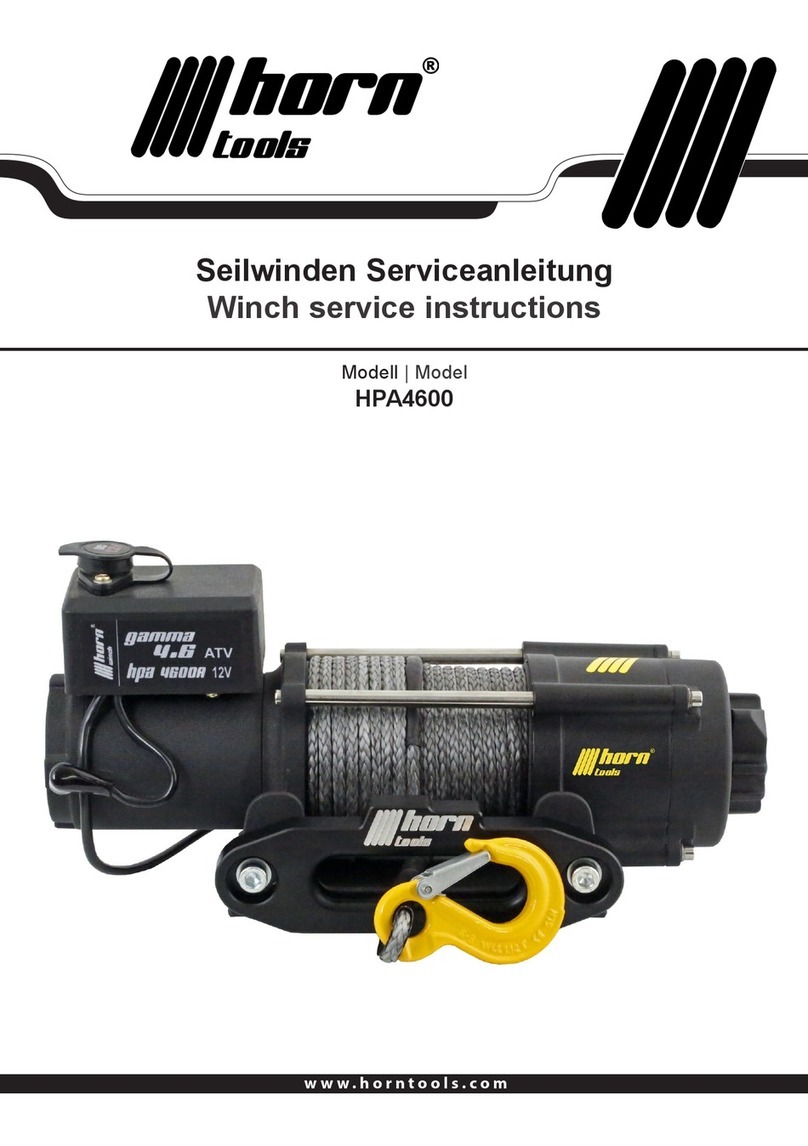
Horn Tools
Horn Tools HPA4600 Service manual
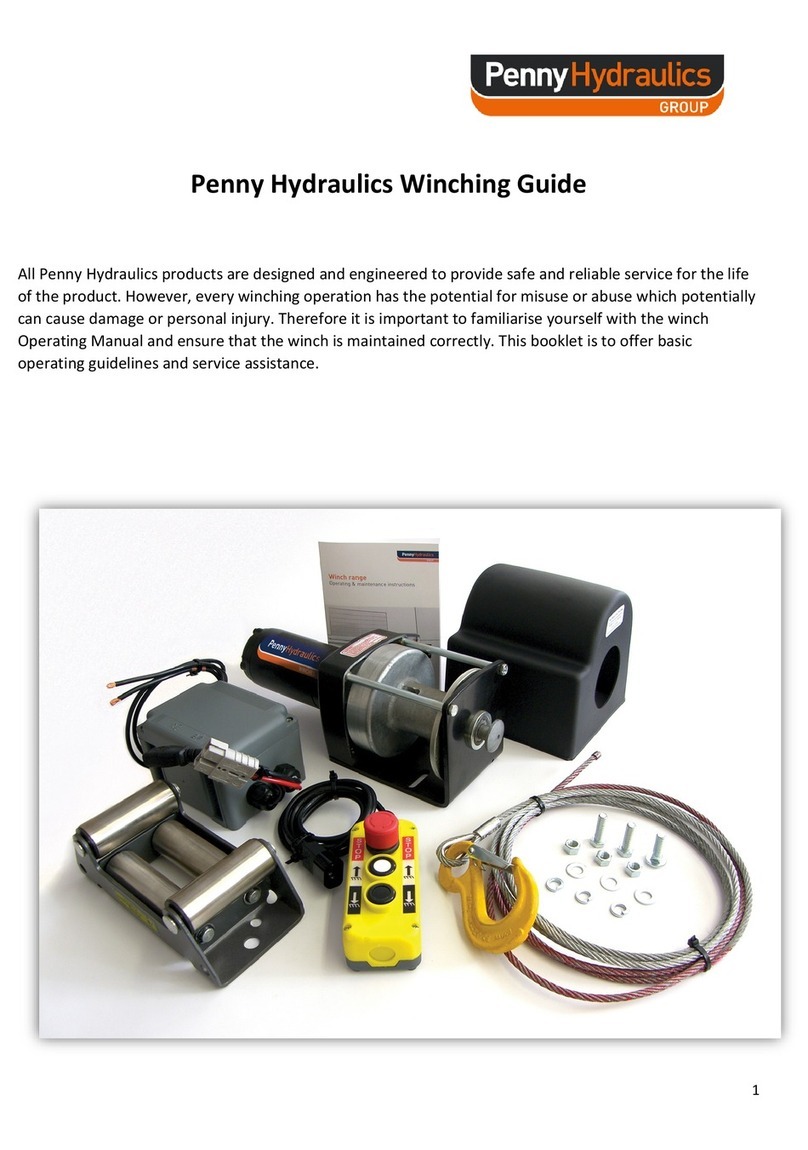
PennyHydraulics
PennyHydraulics PH3312 Winching Guide
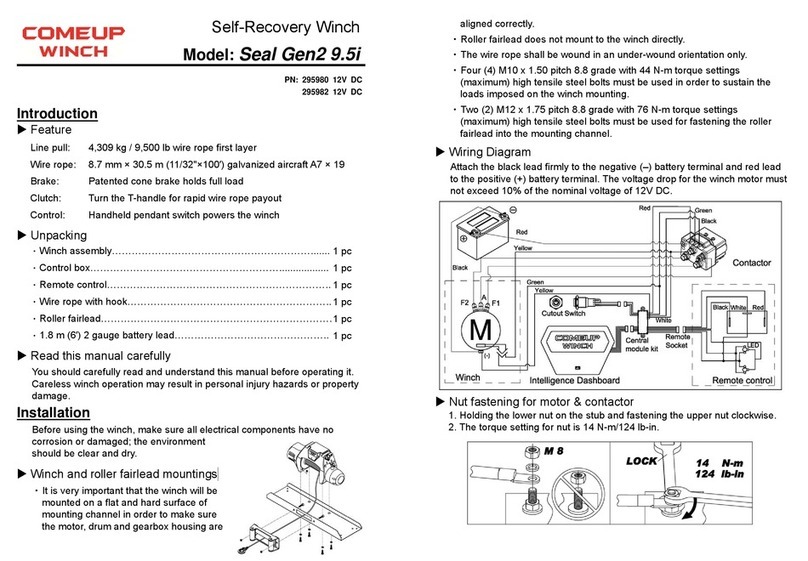
Come.up Winch
Come.up Winch Seal Gen2 9.5i quick start guide

AUTO-XS
AUTO-XS AU315001 Getting started guide
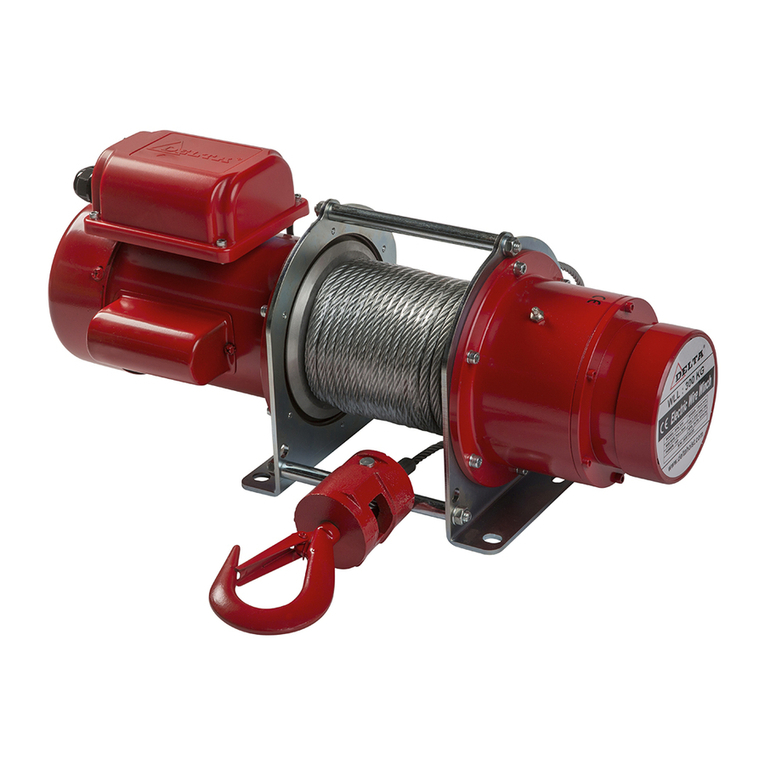
Delta
Delta CP.0.DPS Series Operation manual
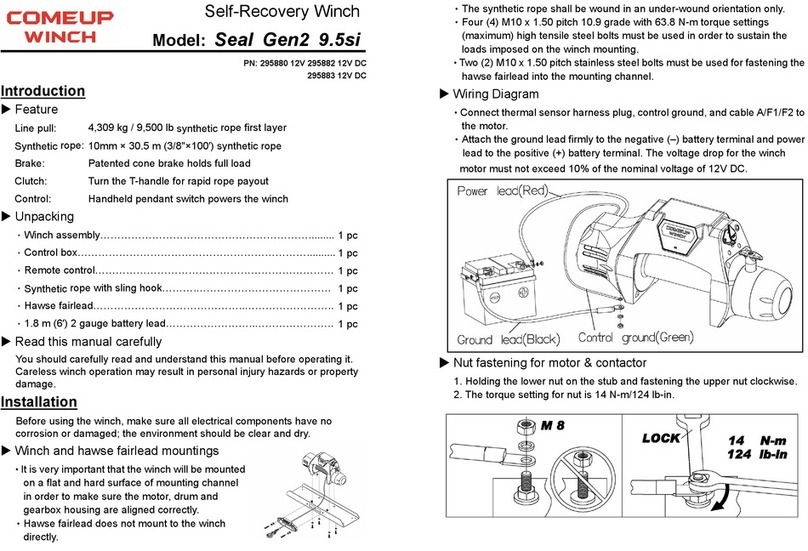
Come.up Winch
Come.up Winch Seal Gen2 9.5si quick start guide




